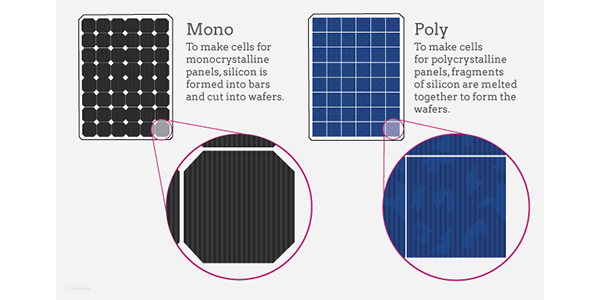What is the Difference Between a Poly and Mono Solar Panels?

Poly Vs. Mono
Solar panels come in two main types: monocrystalline (mono) and polycrystalline (poly). Each has distinct characteristics, advantages, and disadvantages.
Monocrystalline Solar Panels (Mono)
Material: Made from a single, continuous crystal structure of silicon.
Appearance: Usually black or dark blue with rounded edges
.
Pros:
- Higher Efficiency: Monocrystalline solar panels typically have higher efficiency rates (around 15-22%) compared to polycrystalline solar panels. This means they convert more sunlight into electricity, which is ideal for areas with limited space.
- Better Performance in Low Light: They tend to perform better in low light or cloudy conditions due to their higher efficiency and single-crystal structure.
- Longer Lifespan: Generally, they have a longer lifespan and come with a more extended warranty period.
Cons:
- Higher Cost: They are generally more expensive due to the more complex manufacturing process and higher purity of silicon used.
- More Waste During Manufacturing: The production process involves more silicon waste compared to polycrystalline panels.
Polycrystalline Solar Panels (Poly)
Material: Made from silicon crystals melted together in a single batch.
Appearance: Usually blue with a speckled, mosaic-like patter
Pros:
- Lower Cost: Polycrystalline panels are usually cheaper to produce and purchase because the manufacturing process is less complex and results in less silicon waste.
- Good Efficiency: Although not as high as monocrystalline solar panels, polycrystalline solar panels still offer a good efficiency rate (around 13-16%).
Cons:
- Lower Efficiency: They are less efficient than monocrystalline solar panels, which means they require more space to produce the same amount of power.
- Less Aesthetic Appeal: The appearance might be less uniform compared to the sleek look of monocrystalline solar panels, which might be a consideration for some installation
These features make Enphase Systems an attractive option for solar energy systems, providing flexibility, reliability, and advanced technology to meet a wide range of energy needs and challenges.


